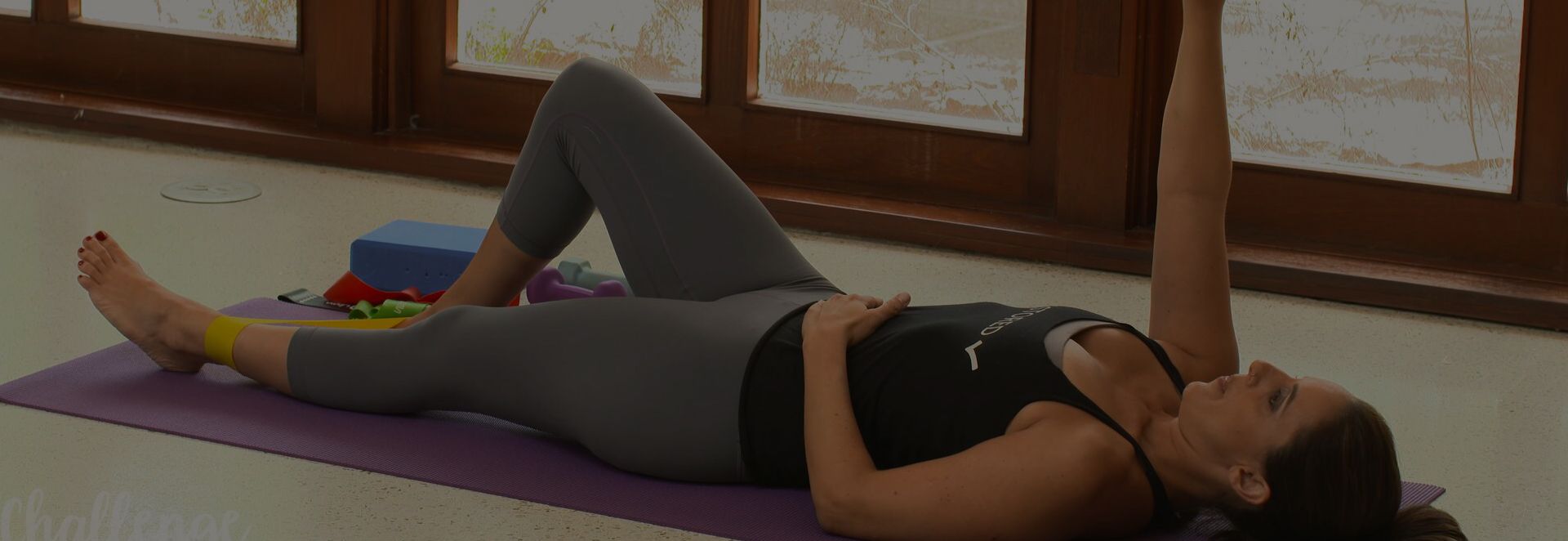Resources
- Breathing and Diastasis Recti: Understanding the Connection and Finding Relief
- Can You Have a Flat Stomach with Diastasis Recti?
- Ab Exercises for Diastasis Recti That Heal, Not Harm
- Can Diastasis Recti Be Fixed Without Surgery?
- How to Choose the Best Diastasis Recti Program?
- Working Out with Diastasis Recti
- How to Fix Diastasis Recti Years Later: A Comprehensive Guide for Long-Term Healing
- Is Diastasis Recti Preventable? | 5 Ways To Prevent Rectus Diastasis
- Can Diastasis Recti Be Fixed Without Surgery?
- Diastasis Recti During Pregnancy
- Before and After: Diastasis Recti
- Can You Fix Diastasis Recti? Exercise Or Surgery
- What Does Diastasis Recti Look Like?
- Self Testing Diastasis Recti | 4 Simple Ways to Test Yourself
- Diastasis Recti Exercises | 8 Exercises for Rectus Diastasis
- Diastasis Recti Exercises For Men
- Is Diastasis Recti Fixable? | Exercise or Surgery
- Diastasis Recti Symptoms | Stomach, Back Pain, Pelvic Floor Issues

in this FREE video and get the support you deserve
*No spam, just quality
content and support
Resources
- Breathing and Diastasis Recti: Understanding the Connection and Finding Relief
- Can You Have a Flat Stomach with Diastasis Recti?
- Ab Exercises for Diastasis Recti That Heal, Not Harm
- Can Diastasis Recti Be Fixed Without Surgery?
- How to Choose the Best Diastasis Recti Program?
- Working Out with Diastasis Recti
- How to Fix Diastasis Recti Years Later: A Comprehensive Guide for Long-Term Healing
- Is Diastasis Recti Preventable? | 5 Ways To Prevent Rectus Diastasis
- Can Diastasis Recti Be Fixed Without Surgery?
- Diastasis Recti During Pregnancy
- Before and After: Diastasis Recti
- Can You Fix Diastasis Recti? Exercise Or Surgery
- What Does Diastasis Recti Look Like?
- Self Testing Diastasis Recti | 4 Simple Ways to Test Yourself
- Diastasis Recti Exercises | 8 Exercises for Rectus Diastasis
- Diastasis Recti Exercises For Men
- Is Diastasis Recti Fixable? | Exercise or Surgery
- Diastasis Recti Symptoms | Stomach, Back Pain, Pelvic Floor Issues
Diastasis Recti Surgery | Procedure Overview | Will You Need It?
By Lauren Ohayon 03/06/2020
4 Min Read
Unfortunately, not everyone will experience healing and make a recovery through rehab and exercise. There may come a time when you will need to consider diastasis recti surgery. DR surgery is not one to take lightly. Here I will address the options to consider if you have a diastasis recti and what the surgical process can be like.
Table of Contents
Diastasis Recti & Concerns
Diastasis recti is not a tearing injury per se, but rather a thinning of the connective tissue that the rectus abdominis (6-pack) muscles attach to, leading to the separation of the muscles. It is most commonly thought to be caused by an imbalance of pressure within your core. This imbalance can be caused by overly toned core muscles, underuse of your abdominal muscles, and even through non optimal breathing patterns.

The concerns regarding a diastasis recti vary depending on the severity of the separation. During a core evaluation or a DR self-test, you or a specialist should be able to determine how large or small the separation is. Typically, a gap that is less than 2.5 cm (two fingers) is considered to be okay, as long as it is shallow and not deep – but you should consider core rehab in order to help prevent the gap from widening over time. Usually a gap that is greater than 2.5 cm requires more attention as symptoms and other health concerns tend to increase with size.
However, if you do have a gap of 2.5 cm or greater, you shouldn’t be frightened. There are rehab programs like my Restore Your Core program that helps rebuild your core, strengthens you, aids in closing your gap, and helps balance your core to help you become more able to accomplish your tasks. Unfortunately, rehab isn’t always successful and surgery becomes your next option. Yet, surgery should be a last resort.
Try Exercise and Rehab First
After being diagnosed with a diastasis recti, the next step (whether you have surgery or not) is to begin a core rehab and strength training program. I always recommend rehab for at least a year before considering surgery.

As mentioned above, in my Restore Your Core Program, which is specifically designed for women suffering from DR, I guide you through many exercises that aid in strengthening your core and help diminish or eliminate and symptoms you are facing.
Exercise and core building therapy is an important step to take during your healing process. However, there are certain exercises that work best and some you should avoid entirely. To understand more on what you should avoid and which exercises are “safe,” click here.
Is Diastasis Recti Surgery Worth It?
You should only consider DR surgery after being enrolled in at least a year of core rehab focusing on corrective exercises and diastasis recti specific strength training. If you have done rehab diligently, and you still notice a significant gap, lower back pain, or leakage, you could consult your doctor and begin discussing whether or not surgery is the right option for you.
Another thing to consider when opting for a diastasis recti surgery is whether or not the gap is causing you pain or any other difficult symptoms. If you are wanting to pursue surgery for cosmetic purposes rather than functionality, it is key to understand that a diastasis recti surgery is highly invasive, and there will be a significant amount of time taken to recover. And, as all surgeries go: the pros should outweigh the cons.
Surgery for Diastasis Recti
Depending on the severity of the diastasis recti, the surgical procedure can range from minimal invasiveness: a procedure called endoscopic-assisted modified abdominoplasty, to a more invasive procedure: abdominoplasty. Surgery for diastasis recti is considered a cosmetic procedure.
What is Involved in DR Surgery?
Surgery for a diastasis recti is substantial and invasive. It is not one to take lightly. A diastasis correction surgery is commonly called a “tummy tuck” or an abdominoplasty. This surgery seeks to tighten the abdominal muscles and remove excess loose skin.

However, it is not a surgery that is approached the same way for every person. Because each body is unique and the severity differs with each individual, the procedure will look differently from person to person. Some people may only need their core muscles tightened through what is called an endoscopic-assisted modified abdominoplasty. This surgery is less invasive and can be accomplished through a bikini line incision with minimal skin removal.
Some surgeries are more complex. For women who may have more stretched skin along with a stomach bulge and a more severe rectus abdominis separation, the surgery can involve skin removal, a larger incision made around the belly button, and even belly button relocation along with skin grafts. Ultimately, the procedure is dictated by the anatomy of the person.
Is Repair of Diastasis Recti Covered by Insurance?
One thing to keep in mind when considering surgery for diastasis recti: in the United States, it is typically not covered by insurance. Unlike a surgery for a hernia, diastasis recti does not run the risk of the intestines getting stuck or damaged in any way. Abdominoplasty is considered a cosmetic surgery so some insurance companies may not consider it a significant procedure. Some physicians say that if you have diastasis recti and it does not cause any problematic symptoms, you can generally live with it. Yet, if it is affecting your everyday life, consider having your physician talk with your insurance company.
If, however, you do opt for surgery, there are a few things you need to prepare yourself for.
How Much Does Diastasis Recti Surgery Cost?
The cost of diastasis recti repair surgery varies. Depending on the experience of the surgeon, the location you are in, and the extent of the repair, the surgery cost can range between $6,900 and $19,000. The average cost for rectus abdominis repair is within the $10,000 – $10,500 range. This will most likely be an out-of-pocket procedure due to that aforementioned fact that cosmetic surgery is usually not covered by insurance. So, if you are considering surgery, be prepared for it to be a fairly expensive procedure.
Sign up for a delivery of inspiration, exclusive offers, contests and the inside scoop on events.
What to Expect in Recovery
If you have pursued surgery under the advice of your doctor, there are a few things to expect and to consider regarding recovery and time. Depending on the severity of your procedure, the time it takes to recover and go through physical therapy to restore your core strength safely can be rather lengthy. Expect to be out of commission for at the very least a week before you are out of bed and trying to readjust to your usual routine. However, some people may experience a healing period of 6 – 12 months before recovering fully.
Planning Ahead
Before your surgery, make sure that you ask your physicians and surgeons any questions that you may have regarding the procedure and what it may involve. Make sure that if the surgery is needed for functional purposes that they understand is it not a cosmetic surgery for you.
How Long Does Diastasis Recti Surgery Take?
Plan for a lengthy surgery time. Although the time it may take to complete the surgery differs from person to person, they can consume much of your day. Be prepared to be under the knife for a few hours.
Understand that after your surgery you will have at least one to two weeks of limited mobility. Plan to have at least a month or two away from work in order to heal properly and begin regaining your strength. However, avoid any core exercises or any strenuous work out sessions for 5 to 6 weeks post-op.
Post-Surgery Recovery
For the first week or so, it may be necessary for you to have assistance throughout the day. For the first week at least you may need to remain in bed and only move about under necessary circumstances. Avoid lying on your side or on your stomach while in bed.
After a week post operation, you can begin to walk around and take on your daily tasks, but avoid any heavy lifting. Doctors typically recommend avoiding lifting anything 10lbs or over. After two weeks or so you may be able to return to your job. However, this may vary depending on the severity of the surgery.
You may experience weakness and body fatigue for up to two or three months post surgery. Make sure that you take ample time to rest and listen to your body if you begin to feel uncomfortable or fatigued.
How Long Does it Take to Recover From Diastasis Recti Surgery?
The effects of the surgery (stomach swelling, scarring, etc.) may take 6 months or even up to 12 months to fully go down or diminish in coloring and size. Once you have regained your strength and believe you are ready to begin building up core strength again, consult a trained professional to outline an exercise routine that would best suit your needs.



